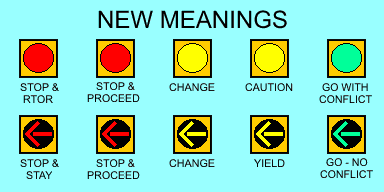The prevention of yellow trap requires the following to occur simultaneously:
- The signal allows a permissive (not protected) left turn through gaps in oncoming traffic.
- The adjacent thru (straight ahead) movement must be stopped by a red signal at the same time.
So what is needed is a permissive left turn indication that can be used when the straight-ahead signal is red.
The circular green indication can't do this, because:
- A circular green without visibility limits also tells the thru movement to go.
- All circular indications facing one approach are required to show the same color.
- A visibility-limited signal can be seen by the wrong movement if the wind can move it.
- Thus, a visibility-limited circular green (Dallas phasing) can't be used with span-wire or swinging mounts.
- Left turning drivers are confused by seeing their circular green next to multiple circular red signals facing the same direction.
Until recently, no indication existed for allowing a permissive turn without also releasing the thru movement.
The flashing yellow arrow fits this need. It was chosen because:
- The old definition was rarely used, and was redundant (same meaning as flashing circular yellow).
- It was provided for night flashing operation in faces without circular indications.
- The old definition of flashing yellow arrow never specified a protected, privileged, or yield permissive movement.
- The old definition of flashing circular yellow specified a yield permissive movement for left and right turns.
- The new definition clarifies the old one, without conflicting with it.
- The new definition requires a yield to conflicting traffic.
- Most drivers figure this out intuitively after seeing a complete signal cycle.
The main difference between the meanings of circular green and flashing yellow arrow:
- To drivers turning left, circular green and flashing yellow arrow have identical meanings.
- To drivers not turning left, circular green and flashing yellow arrow have very different meanings.
This difference is the reason the flashing yellow arrow signal was created.
The idea that the flashing yellow arrow is to "increase driver understanding" came from layman politicians.
- Driver understanding was included in the studies for a different reason: Since a new indication was needed, all new indications proposed had to be tested for the likelihood of driver misunderstanding. But it was not the main purpose of the research.
- These politicians do not understand the hazard of yellow trap, or the difficulty of providing two-way progression.
- They just wanted something to say, so they could open their mouths and appear to know what's going on.
One case where the flashing yellow arrow is misunderstood:
- Some states used the flashing yellow arrow to replace a green arrow during night flash.
- Drivers who have seen this display expect the flashing yellow arrow to give them a privileged right of way, rather than requiring them to yield to conflicting traffic.
When Flashing Yellow Arrows can not be used:
The Flashing Yellow Arrow shall not be used in these cases:
- On single-lane approaches.
- Where an exclusive lane for the turn controlled by the turn signal does not exist.
- Where any lane is shared between the controlled turn and at least one other traffic movement.
- Where multiple lanes make the controlled turn, and conflicts occur as a result.
- Where the left turn crosses multiple streams of traffic.
- Where multiple permissive turns would otherwise enter the same intersection leg.

This signal causes
yellow trap.

This signal can
cause yellow trap.

This signal cures
yellow trap.

This signal also
cures yellow trap.

One sample
sequence
